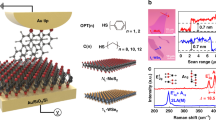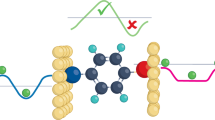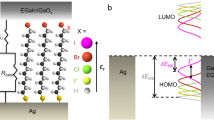Abstract
In the molecular electronics field it is highly desirable to engineer the structure of molecules to achieve specific functions. In particular, diode (or rectification) behaviour in single molecules is an attractive device function. Here we study charge transport through symmetric tetraphenyl and non-symmetric diblock dipyrimidinyldiphenyl molecules covalently bound to two electrodes. The orientation of the diblock is controlled through a selective deprotection strategy, and a method in which the electrode–electrode distance is modulated unambiguously determines the current–voltage characteristics of the single-molecule device. The diblock molecule exhibits pronounced rectification behaviour compared with its homologous symmetric block, with current flowing from the dipyrimidinyl to the diphenyl moieties. This behaviour is interpreted in terms of localization of the wave function of the hole ground state at one end of the diblock under the applied field. At large forward current, the molecular diode becomes unstable and quantum point contacts between the electrodes form.
This is a preview of subscription content, access via your institution
Access options
Subscribe to this journal
Receive 12 print issues and online access
$259.00 per year
only $21.58 per issue
Buy this article
- Purchase on Springer Link
- Instant access to full article PDF
Prices may be subject to local taxes which are calculated during checkout






Similar content being viewed by others
References
Aviram, A. & Ratner, M. A. Molecular rectifiers. Chem. Phys. Lett. 29, 277–283 (1974).
Martin, A. S., Sambles, J. R. & Ashwell, G. J. Molecular rectifier. Phys. Rev. Lett. 70, 218–221 (1993).
Chabinyc Michael, L. et al. Molecular rectification in a metal–insulator–metal junction based on self-assembled monolayers. J. Am. Chem. Soc. 124, 11730–11736 (2002).
Elbing, M. et al. A single-molecule diode. Proc. Natl Acad. Sci. USA 102, 8815–8820 (2005).
Smit, R. H. M. et al. Measurement of the conductance of a hydrogen molecule. Nature 419, 906–909 (2002).
Xu, B. & Tao, N. J. Measurement of single-molecule resistance by repeated formation of molecular junctions. Science 301, 1221–1223 (2003).
Lee, Y., Carsten, B. & Yu, L. Understanding the anchoring group effect of molecular diodes on rectification. Langmuir 25, 1495–1499 (2009).
Morales, G. M. et al. Inversion of the rectifying effect in diblock molecular diodes by protonation. J. Am. Chem. Soc. 127, 10456–10457 (2005).
Venkataraman, L., Klare, J. E., Nuckolls, C., Hybertsen, M. S. & Steigerwald, M. L. Dependence of single-molecule junction conductance on molecular conformation. Nature 442, 904–907 (2006).
Li, X. et al. Conductance of single alkanedithiols. Conduction mechanism and effect of molecule–electrode contacts. J. Am. Chem. Soc. 128, 2135–2141 (2006).
He, J., Fu, Q., Lindsay, S., Ciszek, J. W. & Tour, J. M. Electrochemical origin of voltage-controlled molecular conductance switching. J. Am. Chem. Soc. 128, 14828–14835 (2006).
Xiao, X., Xu, B. & Tao, N. J. Measurement of single molecule conductance: benzenedithiol and benzenedimethanethiol. Nano Lett. 4, 267–271 (2004).
Xu, B., Xiao, X. & Tao, N. J. Measurements of single-molecule electromechanical properties. J. Am. Chem. Soc. 125, 16164–16165 (2003).
Xu, B. Modulating the conductance of a Au–octanedithiol–Au molecular junction. Small 3, 2061–2065 (2007).
Xia, J. L., Díez-Perez, I. & Tao, N. J. Electron transport in single molecules measured by a distance–modulation assisted break junction method. Nano Lett. 8, 1960–1964 (2008).
Haiss, W. et al. Precision control of single-molecule electrical junctions. Nat. Mater. 5, 995–1002 (2006).
Haiss, W. et al. Measurement of single molecule conductivity using the spontaneous formation of molecular wires. Phys. Chem. Chem. Phys. 6, 4330–4337 (2004).
Reichert, J. et al. Driving current through single organic molecules. Phys. Rev. Lett. 88, 176804/1–176804/4 (2002).
Huang, Z. et al. Local ionic and electron heating in single-molecule junctions. Nature Nanotech. 2, 698–703 (2007).
Huang, Z., Xu, B., Chen, Y., Di Ventra, M. & Tao, N. Measurement of current-induced local heating in a single molecule junction. Nano Lett. 6, 1240–1244 (2006).
Tsutsui, M., Taniguchi, M. & Kawai, T. Local heating in metal–molecule–metal junctions. Nano Lett. 8, 3293–3297 (2008).
Ioffe, Z. et al. Detection of heating in current-carrying molecular junctions by Raman scattering. Nature Nanotech. 3, 727–732 (2008).
Stewart, D. R. et al. Molecule-independent electrical switching in Pt/organic monolayer/Ti devices. Nano Lett. 4, 133–136 (2004).
Teramae, Y. et al. High-bias breakdown of Au/1,4-benzenedithiol/Au junctions. Appl. Phys. Lett. 93, 083121 (2008).
Strachan, D. R. et al. Controlled fabrication of nanogaps in ambient environment for molecular electronics. Appl. Phys. Lett. 86, 043109 (2005).
Esen, G. & Fuhrer, M. S. Temperature control of electromigration to form gold nanogap junctions. Appl. Phys. Lett. 87, 263101 (2005).
Boussaad, S. & Tao, N. J. Atom-size contacts and gaps between electrodes fabricated with a self-terminated electrochemical method. Appl. Phys. Lett. 80, 2398–2400 (2002).
Thompson, S. P. & von Engel, A. Field emission of metal ions and microparticles. J. Phys. D. 15, 925–931 (1982).
Oleynik, I. I., Kozhushner, M. A., Posvyanskii, V. S. & Yu, L. Rectification mechanism in diblock oligomer molecular diodes. Phys. Rev. Lett. 96, 096803 (2006).
Perdew, J. P., Burke, K. & Ernzerhof, M. Generalized gradient approximation made simple. Phys. Rev. Lett. 77, 3865–3868 (1996); erratum 78, 1396 (1997).
Nagy, G., Mayer, D. & Wandlowski, T. Distance tunnelling characteristics of solid/liquid interfaces: Au(111)/Cu2 + /H2SO4 . PhysChemComm 5, 112–116 (2002).
Acknowledgements
We thank the National Science Foundation (I.D.-P., Y.L., L.Y., L.A., I.I.O. and N.J.T.), Department of Energy (J.H. and N.J.T.) and the Marie-Curie M.C.-I.O.F. within the European Commission Seventh Framework program (I.D.-P.) for financial support.
Author information
Authors and Affiliations
Contributions
N.J.T. and L.Y. conceived this project. I.D.-P. and J.H. conducted experiments and analysed data. Y.L. synthesized the molecules. I.I.O. designed and supervised the theoretical study and L.A. and M.A.K. did the calculations.
Corresponding authors
Supplementary information
Supplementary information
Supplementary information (PDF 778 kb)
Rights and permissions
About this article
Cite this article
Díez-Pérez, I., Hihath, J., Lee, Y. et al. Rectification and stability of a single molecular diode with controlled orientation. Nature Chem 1, 635–641 (2009). https://doi.org/10.1038/nchem.392
Received:
Accepted:
Published:
Issue Date:
DOI: https://doi.org/10.1038/nchem.392
This article is cited by
-
Nanoscale molecular rectifiers
Nature Reviews Chemistry (2023)
-
Advances in single-molecule junctions as tools for chemical and biochemical analysis
Nature Chemistry (2023)
-
Microscopic theory, analysis, and interpretation of conductance histograms in molecular junctions
Nature Communications (2023)
-
L-Histidine-based computation devices
Pramana (2023)
-
Nanoelectronic circuit elements based on nanoscale metal–molecular networks
Journal of Computational Electronics (2022)



